Yoast vs. All in One SEO: What's Better for Your WordPress Site?

For a new WordPress owner, SEO can be intimidating and confusing. One wrong move and your site could land deep into uncharted search territory (aka page two), never to be seen by a potential customer.
To eliminate some of the confusion and hassle, WordPress site owners seeking to perform their own on-page SEO have two main options: Yoast and All in One SEO (AIO). You have other options, but these two plugins dominate the market as the best SEO plugins you can download. Let's take a look at the pros and cons for each.
On-Page SEO - Building a Solid Foundation
Yoast and All in One focus on technical SEO. Technical SEO is the term given to on-page optimization. On-page optimization makes your code readable by search engines and helps search engines "understand" your site. Technical SEO includes creating great titles, using Meta descriptions, interlinking between pages, site architecture and overall code structure. Search engines are generally good at parsing even poorly formed code, but your visitors' browsers could have problems. Some coding errors harm search engine visibility, and therefore your rank as well. Technical SEO is not limited to the factors discussed above but if you are just getting started, the aforementioned factors are a great place to do so.
Yoast and AIO can help with structure and organization. You don't want to just throw anything and everything at the search engines. You want to index only good content that can be factored into the results. One ranking factor is internal duplication, and these plugins help you remove content that you are a little less proud of. It's tough to accept that some of our content is not worthy of indexing, but it should be removed from the index. These plugins help you do it.
Each search engine is different, but most site owners target Google with a recent interest forming in Bing as a secondary target. That being said, even the combination of Yahoo and Bing can't match the potential traffic that Google offers. For that reason, most SEOs and even these plugin creators focus on Google. The options you'll see in this article are optimized for Google, but you can also use them for Bing.
The takeaway- SEO and related plugins are not a magic bullet. You'll need to continually work on your site, market your value, and add great content each week.
Yoast: The Preferred SEO Plugin
If you ask several SEOs, you'll probably find that Yoast is more popular since it is more feature rich than All in One SEO.
First, let's take a look at the Yoast layout for a new WordPress post.
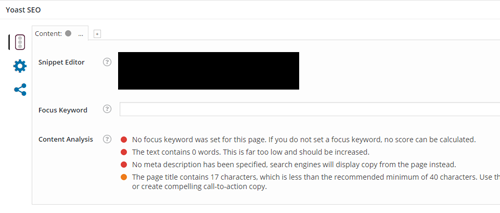
We've blacked out the site name in the snippet preview, but this preview is a real-time look at how your site looks in search engines including the title and Meta description. The focus keyword is the keyword that you've decided to target in the article. Keyword research is an article all on its own, but we just want to make a point that you should be doing keyword research to determine your content marketing topics.
The SEO title is your page title. Remember that the title is seen as the link in search engines, so it should stand out. Finally, the Meta description is the small snippet of content you see under the title.
The real magic in Yoast is the Content Analysis, which is at the bottom of the Yoast panel. Let's take a look at what it does.
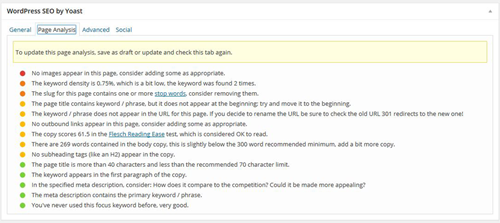
You'll see from this screenshot that Yoast does several checks on the content, the structure of your title and Meta tags, images, and any subheadings. It also gives you a reading score for the content.
This is one part of Yoast that makes it the preferred SEO plugin for WordPress. All in One doesn't have the page analysis and advanced features.
Yoast has the ability to handle the way search engines index your content as does AIO SEO. The Advanced tab (click the wheel in the left panel) has these options in Yoast.
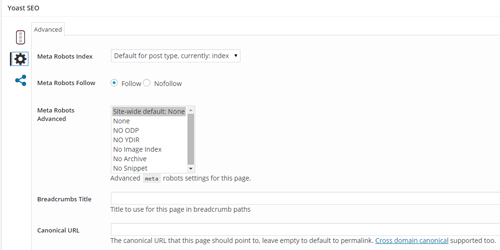
The first "Meta Robots Index" lets you control search engine indexing. You might think that indexing everything is the best approach, but you should "no index" content that isn't ready for prime time or isn't considered quality. The first dropdown gives you this option. One place this option comes in handy is for ecommerce stores with thousands of duplicate product descriptions. You can no-index less important products and focus on re-writing descriptions for popular products if you are in a time crunch.
The "Meta Robots Follow" option tells Google if you want to follow links. Followed links pass link juice, which is the most important ranking factor in Google. If you have any affiliate links or you're linking to questionable content, you want to set this option to no follow. Note that using this option sets no follow on all links including your internal links. You shouldn't no follow your own links, or you run the risk of Google ignoring some of your own content or in extreme cases, you could be penalized for the outdated practice of "Page Rank sculpting."
The "Meta Robots Advanced" has several options. These options control caching, snippets shown, archiving and image indexing. For most bloggers, this setting should be left as "None."
Breadcrumb titles are those small textual links you see at the top of your pages that indicate your location on the blog.
The canonical is another important feature. The canonical setting is used if you have a page that's similar and want to tell search engines to use the alternative page URL instead of the current one. One use is for this setting is to remove duplicate content from the www and non-www versions of your site. You can prevent that issue altogether by setting the preferred domain in the Google Search Console. Canonical URLs are also used to label the original source for syndicated content and to prevent duplicate content issues caused dynamic URLs.
Yoast performs several other technical functionalities. If you want to see your site statistics in Google, you can connect your Google Search Console account with your WordPress site using Yoast. It also integrates with Google Analytics, Facebook, Google+, Alexa and Pinterest. You can also connect to your YouTube channel and LinkedIn profile.
Overall, Yoast is a power house for on-site SEO. When you look in your dashboard and review each post, it even has a column that sets a green or red light for your content. This gives you a quick view of each post and if any of them are lacking optimization. It will also analyze old posts that you've published prior to having the plugin installed. This means that you can retroactively review each post and identify if you need any improvements.
You won't go wrong if you choose Yoast, but let's take a look at All in One SEO and compare its differences.
All in One SEO: Basic Technical On-Site SEO
All in One SEO used to have an exclusive control of the SEO plugin market. It has long been the go-to plugin for SEOs and WordPress site owners. It lost its grip when Yoast started offering the additional options that All in One doesn't support. Even with its limitations, All in One can be seen as a basic technical on-site option for site content.
What makes All in One beneficial over Yoast is that it's very simple. It's for people who already know the ins and outs of SEO and don't need all the page analysis bells and whistles. Yoast is made for people who don't understand SEO, but All in One is for people who already know how to optimize each component of the page.
Let's take a look at All in One's features. First, let's look at the built-in post optimization options shown when you create a new WordPress post.
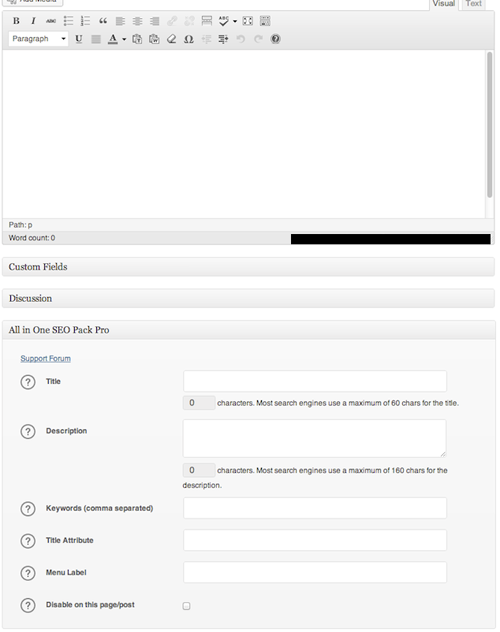
You'll notice that All in One has similar options as Yoast. You type a title, Meta description and keywords after the post content. The difference between Yoast and All in One on this page is that Yoast displays a snippet example of what your link looks like in search engines.
As you can see, All in One has a much more basic input, but any WordPress site owner familiar with SEO doesn't need all the bells and whistles.
Yoast has a sitemap option, but All in One is the winner in this regard.

All in One SEO will automatically create a sitemap for you. Yoast works with sitemaps as well, but it doesn't have the advanced options.
The first benefit is that All in One will "ping" Google and Bing once you publish your sitemap. Pinging tells the search engines that you have new posts or a new sitemap. It triggers a crawl from both search engines, so they will crawl your site and index pages more quickly.
You can get granular with your sitemap. You can index tags, categories, posts and pages. Most site owners just select "All." The last option is to have All in One dynamically create a sitemap. This option is preferred, because it generates a sitemap based on the posts and pages you've published. It ensures that each time search engines crawl your site that they have the latest URLs.
All in One also has general settings that are useful for a site owner. They contain most of the settings for the WordPress site's homepage.
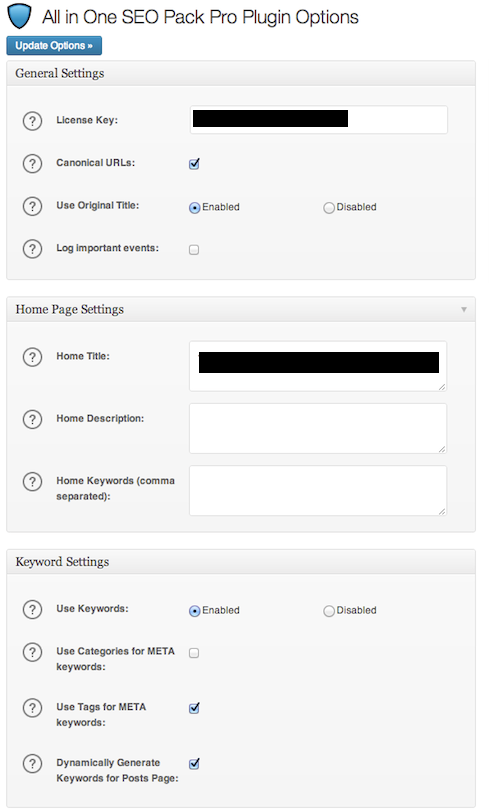
The canonical URL option sets a global canonical for www and non-www duplication. It most cases, you want to check this option. Remember, Yoast lets you work with canonicals page-by-page. It's not always necessary to set a canonical for each page, so this All in One option is actually simpler.
In the homepage settings, you'll recognize that most of these options are also available in the "New Post" page. Remember that these settings are just for the home page of your site, so make them specific to this page and not other sections of your site.
The "Keyword Settings" section is also a bit different than Yoast. This section lets you automatically set keywords in the Meta keywords tag. You can also use your tags for Meta keywords and dynamically create this list with each post. One thing to note with the Meta keywords tag is that it's not used by any major search engine. Generally, this tag doesn't even need to render on the page. Some small, unpopular search engines might use the tag, so it doesn't hurt to use it. It's rumored that a keyword stuffed Meta keyword tag is a spam trigger for Bing, so take that into consideration before you fill this tag with too many phrases, especially unrelated terms.
As you can see, All in One has its benefits. It's simple. It has all the functionality needed to provide on-site optimization for your site provided that you don't need any help with what's needed to properly set up code.
Input from the All in One Team
On my personal blog I created a complete beginner's guide to WordPress SEO and as part of that guide I covered Yoast as the preferred option, this was in early 2014. Recently All in One SEO visited that post and left some comments on a few differentiators between Yoast and AIO SEO, here is what they had to say:
Here are few key differentiators:
1. All in One SEO offers free forum support at WordPress.org. Our competitor does not. You must buy their plugin to get forum support. We do have Pro support for priority requests.
2. We are strongly advising against using a keyword focus tool, because keyword density is losing its relevance as a strategy. And, most good SEOs aren't just focused on one keyword. They are focused on phrases and not keywords. For example, you can have a keyword "Hitachi," but you can't have a keyword "Hitachi power drills under $100." As we move more into semantic search, keywords are limited as to their effectiveness. We are moving to phrases that people may speak into their phone in a mobile search. So, keyword density is not necessarily pointless, but it's no longer as relevant as it may once have been. Therefore, we're on the fence about adding such a tool, when it's not really necessary and adds code bloat and slows load time.
3. One small thing most people have no idea about is that Google Webmaster Tools explicitly states that you should not split your sitemap under 50,000 URLs. All in One SEO Pack has a feature to allow you to split the sitemap and paginate it once you get there. Out competitor splits their sitemap immediately with no ability to turn that feature off. Google has said it has a problem ingesting sitemaps that are split in this way. So, while having a sitemap is not a ranking factor, having a sitemap that functions correctly helps Google spider your pages efficiently.
4. Our user interface it cleaner and more intuitive. We've spent a good deal of time ensuring that you only get what you really need and that it is laid out in an efficient manner. In fact, one SEO on Twitter just let us know he switched back because he simply liked our interface better. He liked out experience, which is just a much nicer and well thought out user interface than our competitors.
I strongly agree with point two, focusing on a single keyword is an outdated practice. Just over a week ago, Yoast released and updated version of their plugin that allows you to optimize a page for more than 1 keyword, this is a premium option and is not included in the free version of the plugin.
Which One Should You Choose?
While Yoast is preferred by many SEOs, it can have more options than you want when you create a post. You might not need all the extra analysis and just want to use the basics in All in One.
Yoast is good for people who don't know where to start. It helps you identify where your pages are weak, and it can guide you toward proper on-site optimization. If you feel more comfortable with analysis and help, Yoast is probably the best for you.
If you're still not sure which one is best for you, here is a breakdown of some of the benefits offered by each plugin.
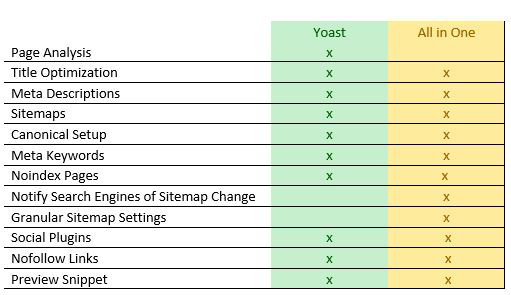
As you can see, both plugins add needed SEO options to your WordPress site. Deciding whether to use Yoast or All in One SEO really just comes down to user preference and needs, both are helpful for beginners looking to improve their on page SEO.
If you are looking for a personal opinion, I am sticking with Yoast. I have used it for years and in doing so, have ranked countless websites, granted I don't pay any attention to the analysis features.
Over to you
Which SEO plugin do you prefer?








